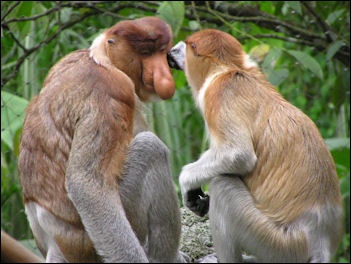PROBOSCIS MONKEYS

Proboscis monkeys are named for their long bulbous noses. They are found in forests along rivers and in swamps and coastal lowlands of Borneo. Indonesians call them "Belanda," which means "white man."[Source: Tim Laman, National Geographic, August 2002]
About 8,000 proboscis monkeys are estimated o be living in the wild. They need relatively large areas to live in to collected all the food need. Proboscis monkeys have had their numbers reduced by poaching and loss of habitat resulting from clearing of the rain forest. Particularly damaging for them has been the drainage of swamps and shrimp farming in coastal habitats.
Proboscis monkeys are one of Asia’s largest monkeys. Adult males can reach lengths of two feet, excluding their tail, and weigh 50 pounds. Females are about half the size. They have long tails which are not used for gripping but may provide balance when then the monkeys fly through the air. They also have very long limbs, ideal for swinging in branches and moving from tree to tree. Infants have dark fur and bluish faces. Twins are rare.
Males have the largest noses. They are long, bulbous and drop downward below the chin. When males grunt their nose jerk upwards. Female noses are significantly smaller and turned up and look like the noses on clowns. Youngsters have short, turned-up button nose. The large male noses are believed to be help them attract females and possible dissipate excess heat.
Proboscis monkeys are great leapers. They can leap great distances from one branch to branch and tree to tree. They push off with their powerful hind legs and fly through the air with their arms extended over their heads, ready to grasp a branch. Mothers leap with their offspring clinging to their stomachs.
Proboscis monkeys have chamber stomachs like ruminants such as cows. They eat large quantities of leaves and rely on bacteria in their stomachs to break down the cellulose in the leaves. These monkeys often spend several hours eating and several hours relaxing while food in their stomachs digests.
Proboscis monkeys eat seeds and green fruits as well as leaves. The have a permanent pot belly, which encloses a large chambered stomach necessary to process all the fibrous food they eat. They avoid sweet fruits which could cause deadly bloating from rapid fermentation. Male proboscis monkeys sometimes move their noses out of the way when they eat.
Studies by Elizabeth Bennett and Carey Yeager,
Proboscis Monkey Swimming

Proboscis monkeys are regarded as the best swimmers among primates . They have partly webbed hands and feet, which helps them swim and may help them walk better on mud. They have been observed swimming on the surface and underwater and making their across large rivers.
One male proboscis monkeys described in National Geographic crossed a 400-foot-wide river by climbing a 30-meter-high tree and, with a running start, leapt as far as he could, hitting the water with a huge belly flop, and almost knocking himself out in the process. He then swam quickly to the shore. Once a group of proboscis monkeys observed leaping in unison from 15-meter-high trees into the water. The strategy is thought to be a way of staying clear of crocodiles.
Proboscis monkeys don’t have a very good sense of direction. Once a fisherman fished one out of the water that was swimming toward China 500 miles away. They also miss their marks. They are Sometimes end up swimming when they attempt to leap from one tree to another and fall short, into the water.
Proboscis Monkey Behavior

Proboscis monkeys live in groups of 10 to 30 members. They have highly organized social structures. Harem groups, with one male and several females and their offspring, are the basic social units. Males, who are usually kicked out of the group at an early age, form all-male groups that hang out together until they are mature enough to challenge other males and form their own harem groups.
Proboscis monkeys groups generally live in a territory that covers about two square kilometers and stay within 400 meters of a river. They spend most of the day foraging for food. At night they gather in the upper canopy of tree along the edge of rivers to sleep. It is unclear why they sleep near rivers. Sometimes different groups sleep relatively close to one another, an unusual habit among monkeys.
Females generally get along well but they do bicker and squabble over choice sleeping and feeding spots. They often chose the feeding spots and males follow them. Although young proboscis stay pretty close to their mothers, females shar in infant care. Mothers may pass their infants off to one another or older siblings.
Proboscis monkeys are relatively unafraid of humans due their contract with researchers. This is good for tourists who can get close without upsetting them.
Mating Proboscis Monkeys

There seems to be no a single breeding season. Male proboscis monkeys try to scare off rivals with bellowing roars and honks. If that doesn’t work they will jump around aggressively shaking trees and branches. Rarely do they actually fight.
Usually a single young is born after a 166 day gestation period. Young proboscis monkeys have dark hair and a bluish face when they are infants. Families often take turns and help each other take care of their offspring.
Image Sources: Wikimedia Commons
Text Sources: National Geographic, Natural History magazine, Smithsonian magazine, Wikipedia, New York Times, Washington Post, Los Angeles Times, Times of London, The Guardian, Top Secret Animal Attack Files website, The New Yorker, Time, Newsweek, Reuters, AP, AFP, The Economist, BBC, and various books and other publications.
Last updated November 2012
